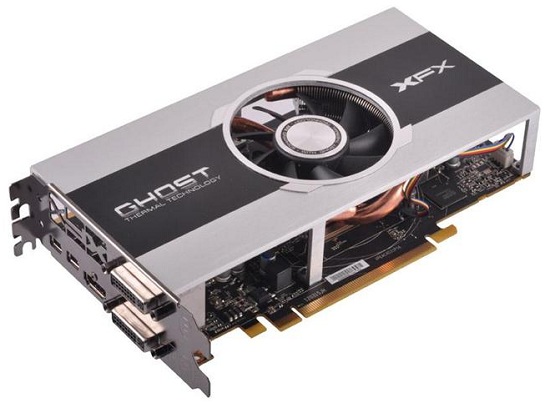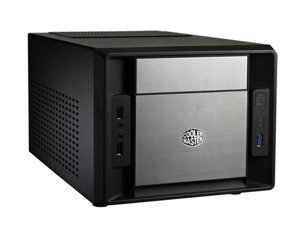Holiday 2012 Small Form Factor Buyer's Guide
by Zach Throckmorton on December 5, 2012 1:55 AM ESTIntel SFF gaming system
The de facto king of the gaming CPUs remains the Intel Core i5-3570K, a quad-core SKU with a base frequency of 3.4GHz that can turbo to 3.8GHz, and features an unlocked multiplier for easy overclocking. Though the K-series chip is easy to overclock and doesn't produce much additional heat (vs. stock) when modestly overclocked, you'll want to exercise caution overclocking in a mini-ITX box.
 To facilitate conservative overclocks of the i5-3570K, ASRock's Z77E-ITX motherboard gets our recommendation for a relatively inexpensive Z77 ITX board that nevertheless performs well. It's also laid out in a manner that facilitates easier cable management than many other Z77 boards when placed in our recommended case, the BitFenix Prodigy. The Prodigy is an interesting case, from its appearance to its internal layout. AnandTech reviewed this unique case recently, and it earned our Editor's Choice. Bluntly, ITX systems are not always a joy to assemble because of the cramped spaces entailed, but I've enjoyed every Prodigy system I've put together.
To facilitate conservative overclocks of the i5-3570K, ASRock's Z77E-ITX motherboard gets our recommendation for a relatively inexpensive Z77 ITX board that nevertheless performs well. It's also laid out in a manner that facilitates easier cable management than many other Z77 boards when placed in our recommended case, the BitFenix Prodigy. The Prodigy is an interesting case, from its appearance to its internal layout. AnandTech reviewed this unique case recently, and it earned our Editor's Choice. Bluntly, ITX systems are not always a joy to assemble because of the cramped spaces entailed, but I've enjoyed every Prodigy system I've put together.
The AMD Radeon HD 7850 1GB yields arguably the best performance for a GPU under $200. Priced roughly the same as the NVIDIA GTX 650 Ti (both can be found around $150 on sale and/or after rebate), the 7850 outperforms the 650 Ti in nearly every metric. You can read more about what to expect from a Radeon HD 7850 1GB card in Ryan's review. Note that in order to accommodate this GPU, you will need to remove the modular drive cage from the Prodigy.
Rounding out the build, we're recommending an 8GB kit of DDR3-1600Mhz (the extremely overclockable Samsung 8GB kit with modest official specs), a standard 1TB hard drive, and like the small form factor file server, a small, modular power supply—the Silverstone ST50F-P.
| Component | Product | Price | Rebate |
| Case | BitFenix Prodigy | $70 | |
| Power supply | Silverstone ST50F-P | $77 | |
| CPU | Intel Core i5-3570K | $215 | |
| Motherboard | ASRock Z77E-ITX | $150 | |
| RAM | Samsung 8GB DDR3-1600MHz | $35 | |
| Graphics card | XFX Core Edition Radeon HD 7850 1GB | $175 | -$20 |
| Hard drive | Seagate ST1000DM003 1TB 7200 RPM | $70 | |
| Optical drive | Samsung SH-224BB | $16 | |
| Operating system | Windows 7 64-bit Home Premium OEM | $92 | |
| Total: | $900 | $880 |
Though this small form factor gaming rig will produce spectacular frame rates in most games, it does so at a price. If you primarily play less demanding games, or play at resolutions lower than 1080p, you can save a lot of money by going with the AMD APU small form factor gaming build we'll detail next.
AMD SFF gaming system
I recently posted an AMD Trinity APU buyer's guide, in which I highlighted the A10-5800K's gaming abilities. Briefly, Crysis: Warhead, Metro 2033, DiRT 3, Total War: Shogun 2, Portal 2, Battlefield 3, Starcraft 2, Elder Scrolls V: Skyrim, Civilization V, World of Warcraft, Left 4 Dead, Diablo 3, Aliens vs. Predator, and Minecraft are all very playable (at least 50-60fps) at 720p resolution and moderate details. Gaming at higher resolutions like 1680x1050 changes consideration of the A10-5800K as a "good enough" gaming processor. Metro 2033 and Aliens vs. Predator in particular start to struggle, and maintaining average frame rates higher than 40fps requires lowering quality settings in most of the remaining titles listed above. You can read more about the top of the line AMD APU's gaming performance in Anand's review.
Unfortunately there are very few Socket FM2 motherboards available in American retail channels that use the ITX form factor. Of the two I've tried, I prefer the MSI FM2-A75IA-E53 because its SATA ports, USB 3.0 front panel header, and 24 pin power connector are all adjacent to each other, which makes stringing cables throughout a small ITX case that much easier.
 Housing the A10 APU and its MSI FM2 motherboard is the Cooler Master Elite 120. Dustin reviewed this case and I agree with his main conclusions: its thermals are somewhat limited and it's better suited to more modest systems. As we've outlined below, there's no discrete GPU in this build, so that concern is simply irrelevant. If you decide to run Hybrid Crossfire aka Dual Graphics at some point in the future, the GPUs recommended for pairing with the A10-5800K are physically small and have relatively low TDPs, so the Elite 120's limited thermals should remain a non-issue. Best of all, this is a lot of case for not much money given its $50 MSRP.
Housing the A10 APU and its MSI FM2 motherboard is the Cooler Master Elite 120. Dustin reviewed this case and I agree with his main conclusions: its thermals are somewhat limited and it's better suited to more modest systems. As we've outlined below, there's no discrete GPU in this build, so that concern is simply irrelevant. If you decide to run Hybrid Crossfire aka Dual Graphics at some point in the future, the GPUs recommended for pairing with the A10-5800K are physically small and have relatively low TDPs, so the Elite 120's limited thermals should remain a non-issue. Best of all, this is a lot of case for not much money given its $50 MSRP.
AMD APUs benefit from faster DDR3, so we're recommending a kit of DDR3-1866MHz here. Take care to not buy a kit that has unnecessarily heatspreaders, as space is at a premium in this ITX build. As stated earlier, hard drive prices are highly variable right now, so keep your eyes on prices. We're recommending a standard 1TB 7200 RPM drive here, which should accommodate even larger gaming libraries. Finally, powering everything we have a standard budget PSU, Antec's Neo Eco 400C. If the Neo Eco 400C isn't priced well in your area of the world, you can always consider the Corsair Builder Series 430W, Antec Earthwatts 380W, or even the Seasonic 300W.
| Component | Product | Price |
| Case | Cooler Master Elite 120 | $40 |
| Power supply | Antec Neo Eco 400C | $40 |
| CPU | AMD A10-5800K APU | $130 |
| Motherboard | MSI FM2-A75IA-E53 | $90 |
| RAM | GEIL Evo Leggara 8GB DDR3-1866MHz | $43 |
| Hard drive | Seagate ST1000DM003 1TB 7200 RPM | $70 |
| Optical drive | Samsung SH-224BB | $16 |
| Operating system | Windows 7 64-bit Home Premium OEM | $92 |
| Total: | $521 |
We have a few concluding remarks on the final page.










74 Comments
View All Comments
Avendit - Thursday, December 6, 2012 - link
Its not so much signal issues I've had as earthing problems. Using a copper co-ax for digital out on my media PC gave a loud pop every time the audio fired up and dts sync'd. Switch to optical and the problem goes away. I could see the same thing being possible with HDMI.It might be something unique to systems a size down from these - I'm talking systems with laptop style power bricks, hence the earthing problem I think. But its also passive and does just enough for a media PC, albeit with most content stored over the network.
Avendit
ender8282 - Thursday, December 6, 2012 - link
I took the comment to refer to better isolation of the audio system. I believe that the fear is that a a copper cable running from the computer to the audio system could introduce a ground loop and cause issues.Guspaz - Thursday, December 6, 2012 - link
HDMI is prone to interference, digital or otherwise. If you've ever suffered from interference on an HDMI cable, you'd see it as coloured snow on the image. It's hard to describe, it's like, imagine you have a large number of stuck pixels, except their location changes every frame.I get this from my PS3 to my U2711 when using deep colour. It requires more bandwidth, so the signal is less robust (generally, the higher bandwidth your HDMI signal, the more prone to interference). I'm using a rather thin cable (28AWG), so even though the total length of the cable run isn't very long (~15 feet total), there's some interference problems due to the high bandwidths involved.
I have no such problems from my PS3 to my projector, despite using a much longer cable (PS3 -> HDMI switch -> U2711 or projector), because the cable going from my switch to my TV is a MUCH thicker cable.
Midwayman - Thursday, December 6, 2012 - link
Even two years ago you had to work hard not to buy a unit without HDMI. No reason to eliminate choices, but if you have to pick one or the other, HDMI is the future. Granted HDMI is a pretty crappy standard in many ways, but its what consumer gear uses for better or worse.Guspaz - Thursday, December 6, 2012 - link
HDMI cables using RedMere chips have similar thicknesses to good optical TOSLINK cables at up to 15 chips. They do cost a lot more, but they're still available at MonoPrice, so at least you know the premium isn't ripping you off.Normally, a typical HDMI cable uses 28AWG conductors for up to 15 feet, RedMere can use 36AWG conductors for up to the same distance. That's a pretty enormous reduction in size, and it should be more resistant to interference to boot.
Over 15 feet, though... At 30 feet, regular HDMI is going to be something like 24AWG, while RedMere bumps it up to 28AWG.
HisDivineOrder - Monday, December 10, 2012 - link
Pssst. AnyDVD HD+XBMC 12 Frodo.
You're welcome.
lmcd - Thursday, December 6, 2012 - link
I'm pretty sure even an AMD A4 can do the off-frame rates more accurately than Intel's IGPs, so I'd consider an AMD build in that case.Metaluna - Thursday, December 6, 2012 - link
Personally, for HTPC I prefer a slim desktop-style microATX case, like the Antec NSK2480 or equivalent Silverstone. Plenty of room inside for a large GPU and/or tuner card, and several drives. Much easier to work in, and, unlike these wierd shoebox cases, they actually stack nicely with other HT components like receivers or BD players.drewpsu - Friday, December 7, 2012 - link
Thanks to network tuners from an HDHomeRun, my HTPC is mini-ITX without having to worry about internal tuner cards.cyrusfox - Wednesday, December 5, 2012 - link
When it comes to budget itx builds(media center or file server), I really think the new Celeron Mobile 847(SB) boards Rock. I got one coming to my place tomorrow to be my tv box.Check'er out
http://www.newegg.com/Product/Product.aspx?Item=N8...
Sandybridge mobile performance for $80(superbiiz), Sure it is only 1.1 GHz - 2 cores, but should be able to handle 1080p hulu or netflix streams and the TDP at 17W, tiny, perfect for those insane small ITX cases like a Wesena itx2 case or heatsink streacom case(silent media box). Goodbye brazos, its been a good 23 months.